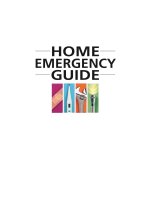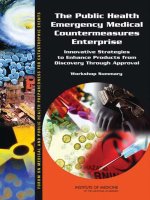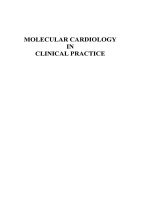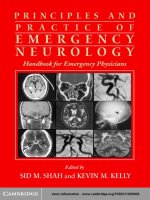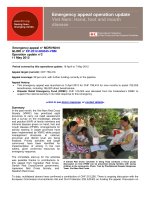Emergency Cardiology, 2E Ratib, Karim, Bhatia, Gurbir, Uren, Neal, Nolan, James
Bạn đang xem bản rút gọn của tài liệu. Xem và tải ngay bản đầy đủ của tài liệu tại đây (2.71 MB, 289 trang )
EMERGENCY
CARDIOLOGY
This page intentionally left blank
EMERGENCY
CARDIOLOGY
AN EVIDENCE-BASED GUIDE TO ACUTE CARDIAC PROBLEMS
Second Edition
Karim Ratib MBCHB BSC (HONS) MRCP
Specialist Registrar in Cardiology, University Hospital of North
Staffordshire, Stoke-on-Trent, UK
Gurbir Bhatia MBCHB MD MRCP
Specialist Registrar in Cardiology, University Hospital of North
Staffordshire, Stoke-on-Trent, UK
Neal Uren MD (HONS) FRCP
Consultant Cardiologist, Edinburgh Heart Centre, Royal Infirmary,
Edinburgh, UK
James Nolan MBCHB MD FRCP
Consultant Cardiologist, University Hospital of North Staffordshire,
Stoke-on-Trent, UK
First published in Great Britain in 2003 by Hodder Arnold
This second edition published in 2010 by
Hodder Education, an Hachette UK Company,
338 Euston Road, London NW1 3BH
© 2011 Karim Ratib, Ghurbir Bhatia, Neal Uren and James Nolan.
All rights reserved. Apart from any use permitted under UK copyright law, this publication
may only be reproduced, stored or transmitted, in any form, or by any means with prior
permission in writing of the publishers or in the case of reprographic production in
accordance with the terms of licences issued by the Copyright Licensing Agency. In the
United Kingdom such licences are issued by the Copyright Licensing Agency: Saffron
House, 6–10 Kirby Street, London EC1N 8TS.
Whilst the advice and information in this book are believed to be true and accurate at the
date of going to press, neither the author[s] nor the publisher can accept any legal
responsibility or liability for any errors or omissions that may be made. In particular (but
without limiting the generality of the preceding disclaimer) every effort has been made to
check drug dosages; however it is still possible that errors have been missed. Furthermore,
dosage schedules are constantly being revised and new side-effects recognized. For these
reasons the reader is strongly urged to consult the drug companies’ printed instructions
before administering any of the drugs recommended in this book.
British Library Cataloguing in Publication Data
A catalogue record for this book is available from the British Library
Library of Congress Cataloging-in-Publication Data
A catalog record for this book is available from the Library of Congress
ISBN-13 978 0 340 974 223
1 2 3 4 5 6 7 8 9 10
Commissioning Editor:
Project Editor:
Production Controller:
Cover Designer:
Indexer:
Caroline Makepeace
Sarah Penny
Kate Harris
Lynda King
David Bennett
Typeset in Minion Pro 9.5pt by MPS Limited, A Macmillan Company
Printed and bound in India by Replika Press Pvt Ltd
What do you think about this book? Or any other Hodder Arnold title?
Please visit our website: www.hodderarnold.com
CONTENTS
Abbreviations
vi
CHAPTER 1
Acute Coronary Syndromes
1
CHAPTER 2
Resuscitation
84
CHAPTER 3
Arrhythmias
104
CHAPTER 4
Hypertensive Emergencies
135
CHAPTER 5
Acute Aortic Syndromes
149
CHAPTER 6
Acute Pulmonary Embolism
167
CHAPTER 7
Infective Endocarditis
188
CHAPTER 8
Drug-related Cardiac Problems
203
CHAPTER 9
Pericarditis
218
CHAPTER 10 Cardiac Trauma
225
CHAPTER 11 Cardiac Tamponade
234
Appendices
239
Index
269
ABBREVIATIONS
ACC
ACD
ACE
ACS
ACT
ADP
AF
AHA
aPTT
ATP
A-V
AV
AVNRT
AVRT
BP
BSAC
CABG
CAD
cAMP
CCS
CCU
CK
CMV
COPD
CPR
CRP
CT
CTPA
CVA
DAPT
DCC
DES
DVT
ECG
EF
vi
American College of Cardiology
active and compression–decompression
angiotensin converting enzyme
acute coronary syndrome
activated clotting time
adenosine diphosphate
atrial fibrillation
American Heart Association
activated partial thromboplastin time
adenosine triphosphate
arteriovenous
atrioventricular
atrioventricular nodal re-entry tachycardia
atrioventricular re-entry tachycardia
blood pressure
British Society of Antimicrobial Chemotherapy
coronary artery bypass graft
coronary artery disease
cyclic adenosine monophosphate
Canadian Cardiovascular Society
coronary care unit
creatine kinase
cytomegalovirus
chronic obstructive pulmonary disease
cardiopulmonary resuscitation
C-reactive protein
computed tomography
computed tomography pulmonary angiography
cerebrovascular accident
dual antiplatelet therapy
direct current cardioversion
drug-eluting stent
deep venous thrombosis
electrocardiogram
ejection fraction
ABBREVIATIONS
ELISA
EMD
EPS
ERC
ESR
ESC
FDP
GI
GP
GRF
GTN
HIT
IABP
IAC
ICD
IE
IHD
IMH
INR
IPG
IRA
IRAD
IV
IVDU
JVP
LAD
LIMA
LMWH
LSD
LVF
MACE
MEN
MI
MIC
MRI
MRSA
NICE
NPCT
NSTEACS
NSTEMI
PAU
enzyme-linked immunoadsorbent assay
electromechanical dissociation
electrophysiological study
European Resuscitation Council
erythrocyte sedimentation rate
European Society of Cardiology
fibrin degradation products
gastrointestinal
glycoprotein
gelatin–resorcinol–formaldehyde
glyceryl trinitrate
heparin-induced thrombocytopenia
intra-aortic balloon counterpulsation
interposed abdominal compression
implantable cardioverter defibrillator
infective endocarditis
ischaemic heart disease
intramural haematoma
international normalized ratio
impedance plethysmography
infarct-related artery
International Registry of Acute Aortic Dissection
intravenous
intravenous druge user
jugular venous pressure
left anterior descending (artery)
left internal mammary artery
low molecular weight heparin
lysergic acid diethylamide
left ventricular failure
major adverse cardiac event
multiple endocrine neoplasia
myocardial infarction
minimum inhibitory concentration
magnetic resonance imaging
methecillin resitant staphyloccocus aureus
National Institute for Health and Clinical Excellence
non-penetrating cardiac trauma
non-ST elevation ACS
non-ST elevation MI
penetrating atherosclerotic ulceration
vii
ABBREVIATIONS
PCI
PE
PEA
PLS
po
PTCA
PTD
PTFE
SBP
SC
SLE
STEMI
SVT
TCAD
TIA
TOE
tPA
TVR
UA
UFH
V/Q
VF
VT
WCC
WPW
viii
percutaneous coronary intervention
pulmonary embolism
pulseless electrical activity
posterior leucoencephalopathy syndrome
per os (orally)
percutaneous transluminal coronary angioplasty
percutaneous thrombolytic device
polytetrafluoroethylene
systolic blood pressure
subcutaenous
systemic lupus erythematosus
ST elevation MI
supraventricular tachycardia
tricyclic antidepressant
transient ischaemic attack
transoesophageal echocardiogram (echocardiography)
tissue plasminogen activator
target vessel revascularization
unstable angina
unfractionated heparin
ventilation/perfusion
ventricular fibrillation
ventricular tachycardia
white cell count
Wolff–Parkinson–White (syndrome)
CHAPTER 1
ACUTE CORONARY SYNDROMES
Epidemiology
Definitions
Pathophysiology
Diagnosis
Initial treatment
Treatment of ST elevation MI
Primary PCI
Thrombolysis
Treatment of non-ST
elevation ACS
Risk scores in NSTEACS
1
2
3
6
17
19
20
23
31
Revascularization strategies
in NSTEACS
Bleeding risk in ACS
Adjunctive medical therapy
Complications of ACS
Early peri-infarction arrhythmias
Late post-infarction arrhythmias
Recovery and rehabilitation
Key points
Key references
36
38
40
54
65
76
77
79
80
33
EPIDEMIOLOGY
Coronary heart disease is the most common cause of death in the United
Kingdom. In total, 220 000 deaths were attributable to ischaemic heart
disease in 2007. It is estimated that the incidence of acute coronary
syndrome (ACS) is over 250 000 per year.
Sudden death remains a frequent complication of ACS: approximately
50 per cent of patients with ST elevation myocardial infarction (STEMI)
do not survive, with around two-thirds of the deaths occurring shortly
after the onset of symptoms and before admission to hospital. Prior to
the development of modern drug regimes and reperfusion strategies,
hospital mortality after admission with ACS was 30–40 per cent. After the
introduction of coronary care units in the 1960s, outcome was improved,
predominantly reflecting better treatment of arrhythmias. Current therapy
has improved outcome further for younger patients who present early in
the course of their ACS. The last decade has seen a significant fall in the
overall 30-day mortality rate. Most patients who die before discharge do
so in the first 48 hours after admission, usually due to cardiogenic shock
consequent upon extensive left ventricular damage. Most patients who
survive to hospital discharge do well, with 90 per cent surviving at least
1 year. Surviving patients who are at increased risk of early death can be
identified by a series of adverse clinical and investigational features, and
their prognosis improved by intervention.
EPIDEMIOLOGY 1
ACUTE CORONARY SYNDROMES
DEFINITIONS
The term ‘acute coronary syndrome’ (ACS) has been developed to describe
the collection of ischaemic conditions that include a spectrum of diagnoses
from unstable angina (UA) to non-ST elevation MI (NSTEMI) and STEMI.
Patients presenting with ACS can be classified into two groups according
to their electrocardiogram (ECG) (Figure 1.1): those with persistent STEMI
and those without (non-ST elevation ACS or NSTEACS). The treatment of
STEMI requires emergency restoration of blood flow within an occluded
culprit coronary artery. Patients presenting with NSTEACS often have
ECG changes including T-wave inversion, ST depression or transient ST
elevation, although occasionally the ECG may be entirely normal. This
group can be classified further according to the presence of detectable
levels of cardiac proteins, troponins, in patients’ serum (see below). Thus,
NSTEACS patients with undetectable cardiac troponins (UA) are
distinguished from those in whom myocardial ischaemia is severe enough
to cause myocardial necrosis, leading to troponin release into the
circulation (NSTEMI). Detection of cardiac troponin following ACS is a
strong predictor of recurrent ischaemia. However, it should be remembered
that patients with UA are still at increased risk of further events, especially
those with pain at rest or dynamic ST changes on their ECG.
ACS
ECS
Persistent
ST elevation
STEMI
ST change
T-wave inversion
Normal ECG
NSTEACS
Diagnosis
NSTEMI
Management
Reperfusion
Invasive / Non-invasive
Figure 1.1 Definition, diagnosis and management of ACS.
2 DEFINITIONS
UA
ACUTE CORONARY SYNDROMES
Myocardial infarction can also be classified with regards to underlying
aetiology as defined by the European Society of Cardiology:
Type 1 Spontaneous myocardial infarction related to ischaemia due to
a primary coronary event such as plaque erosion and/or rupture,
fissuring or dissection.
Type 2 Myocardial infarction secondary to ischaemia due to either
increased oxygen demand or decreased supply, e.g. coronary artery
spasm, coronary embolism, anaemia, arrhythmias, hypertension or
hypotension.
Type 3 Sudden unexpected cardiac death, including cardiac arrest,
often with symptoms suggestive of myocardial ischaemia,
accompanied by presumably new ST elevation, or new LBBB, or
evidence of fresh thrombus in a coronary artery by angiography and/or
at autopsy, but death occurring before blood samples could be
obtained, or at a time before the appearance of cardiac biomarkers in
the blood.
Type 4a Myocardial infarction associated with PCI (percutaneous
coronary intrervention).
Type 4b Myocardial infarction associated with stent thrombosis as
documented by angiography or at autopsy.
Type 5 Myocardial infarction associated with CABG (coronary artery
bypass graft).
PATHOPHYSIOLOGY
ACSs are caused by an imbalance between myocardial oxygen demand
and supply that results in cell death and myocardial necrosis. Primarily,
this occurs due to factors affecting the coronary arteries, but may also
occur as a result of secondary processes such as hypoxaemia or
hypotension and factors that increase myocardial oxygen demand. The
commonest cause is rupture or erosion of an atherosclerotic plaque that
leads to complete occlusion of the artery or partial occlusion with distal
embolization of thrombotic material.
Atherosclerosis is a disease of large and medium-sized arteries, affecting
predominantly the arterial intima. The precise mechanism responsible for
the generation of atherosclerotic arterial disease remains open to debate, but
it is likely that arterial endothelial injury is an initiating factor. It is clear that
PATHOPHYSIOLOGY 3
ACUTE CORONARY SYNDROMES
the extent and stability of atherosclerotic lesions is influenced by the
common risk factors of smoking, hypertension, hyperlipidaemia and
diabetes. There are a large number of other modifiable risk factors, such as
homocysteine, oxidative stress, fibrinogen and psychosocial factors, which
may play an important role in atherogenesis in some individuals. Individual
susceptibility to the adverse effects of risk factors may relate to genetic
predisposition.
Atherosclerotic plaques are complex structures consisting of a fibrous cap
and a core of lipid, connective tissue and inflammatory cells. The
morphology of plaques is variable, and those with a thin fibrous cap, a large
lipid core and an increase in inflammatory activity are highly unstable. An
increase in inflammatory activity within plaques may be triggered by
systemic infections (Chlamydia, cytomegalovirus (CMV), Helicobacter or
chronic dental sepsis) or stimuli such as stress, severe exercise and
temperature change. ACS is initiated when the fibrous cap of an unstable
atherosclerotic lesion ruptures (in 75 per cent of cases) or the overlying
endothelium erodes (in 25 per cent of cases). Plaque erosion is more
common in females. Both mechanisms expose highly thrombogenic
subendothelial and core components of the unstable plaque to the blood,
leading to localized platelet adhesion, activation of the clotting mechanism,
and formation of an intraluminal thrombus that occludes the coronary
artery. Prior to plaque rupture or erosion, other conformational changes
may occur as a result of endothelial injury. This causes a proliferation of
smooth muscle cells leading to a reduction of the luminal diameter, which
increases shear stress, and causes further endothelial injury. Intravascular
ultrasound studies have confirmed that unstable coronary plaques are
associated with more expansive arterial remodelling compared to stable
coronary lesions, which may imply a more marked recent progression in
extent and severity of plaque at the site of rupture/erosion. Angiographic
and intravascular ultrasound studies of culprit lesions have demonstrated
complex eccentric morphology consistent with ruptured plaque and
superimposed thrombus. Vulnerable plaques that fissure or rupture are
characterized by large eccentric lipid pools with foam cell infiltration and
tend to rupture at the border of the fibrous cap and adjacent normal intima.
This weakness in the integrity of the plaque is initiated by matrix
metalloproteinases secreted by macrophages, and ultimately rupture occurs
through an acute change in wall shear stress.
The lipid core is a potent substrate for platelet-rich thrombus formation with
the initiation of the coagulation cascade through the interaction of tissue
factor with factor VIIa. Platelet adhesion to subendothelial collagen through
4 PATHOPHYSIOLOGY
ACUTE CORONARY SYNDROMES
the release of tissue factor and the expression of the vitronectin (αvß3)
receptors leading to platelet activation and aggregation through the expression
of the glycoprotein IIb/IIIa receptor is an important event in the development
of thrombus. Platelet-rich thrombus is associated with cyclical reductions in
coronary blood flow with additional coronary vasoconstriction resulting from
endothelial disruption, and thromboxane A2 (TXA2) and serotonin production
leading to reduced nitric oxide (NO) production. Inflammatory acute phase
proteins, cytokines and systemic catecholamines stimulate the production of
tissue factor, procoagulant activity and platelet hypercoagulability.
A number of factors that can trigger the onset of ACS have been identified,
acting by initiating plaque rupture or promoting thrombus formation.
Some patients report heavy physical exertion or mental stress shortly
before the onset of ACS. Circadian variation in coagulation and
autonomic nervous system activity contribute to an increased incidence of
ACS in the morning. Irrespective of this, the risk of an individual episode
of exercise or stress precipitating the onset of ACS is low, and most
episodes have no identifiable direct triggers.
Other non-athersclerotic causes for ACS include arteritis, trauma,
spontaneous coronary dissection, thromboembolism, cocaine use and
congenital abnormalities such as anomalous coronary arteries. Patients
who present as a result of these rare causes will usually not have the
classical risk factors associated with atherosclerosis; typically the
diagnosis is not established until after coronary angiography.
Acute STEMI usually results from total occlusion of a coronary artery, with
subsequent myocardial cell necrosis occurring in as little as 15 minutes.
Continued occlusion results in a wavefront of necrosis spreading from the
subendocardium to the subepicardium. The amount of myocardial injury
depends on the duration of occlusion, the presence of collateral blood flow
and the degree of preconditioning of the myocytes to ischaemia. In animal
models, persistent occlusion of a coronary artery will usually result in
complete infarction of the area subtended after 6 hours. Subendocardial and
full thickness or transmural mycocardial infarction can be well
demonstrated with cardiac magnetic resonance imaging (MRI) using late
gadolinium enhanced images. These images correlate well with
macroscopic histological findings.
NSTEACS are usually associated with partial or transient occlusion of the
coronary artery that may result in ST depression or T-wave changes on
the ECG. Myocardial injury occurs as a result of a sudden decrease in
luminal diameter leading to reduced perfusion or due to plaque
PATHOPHYSIOLOGY 5
ACUTE CORONARY SYNDROMES
rupture/erosion and embolization of thrombotic material into the distal
coronary bed. Most individuals with atherosclerotic coronary artery disease
have a large number of minor lesions that do not significantly narrow the
coronary lumen, as well as a smaller number of severe lesions. The severe
lesions are more likely to intermittently limit antegrade blood flow during
exercise (leading to stable angina). An ACS is more likely to occur due to
instability in one of the more numerous minor lesions (two-thirds of ACS
are related to angiographically minor lesions). Intravascular ultrasound
studies have shown that patients with NSTEACS frequently have multiple
ruptured plaques often occurring in arteries other than the initial culprit.
UA can be caused by the same mechanisms as NSTEMI, although the
detectable myocardial necrosis does not usually occur. UA may also be
caused by a reduction in coronary flow due to a decrease in luminal diameter
caused by increase in size of a non-ruptured plaque where endothelial
damage leads to smooth muscle proliferation. For these reasons, patients
even with negative biomarkers may still be at high risk of further events and
this reinforces the need for effective risk stratification.
DIAGNOSIS
Presentation
Chest pain is a common reason for patients to attend hospital, accounting
for up to 5 per cent of visits to the emergency department and 40 per cent
of hospital admissions. Around 50 per cent of patients presenting with
chest pain will have an underlying ACS, requiring hospitalization and
intensive medical therapy. The remainder have other cardiac and
non-cardiac causes for their symptoms, and require a different
management approach. This section gives guidelines on diagnosing ACS,
and differentiating it from other common causes of chest pain.
The diagnosis of ACS is usually made using a combination of clinical and
ECG features. Cardiac troponin studies and functional tests can then be
used to further risk-stratify the patient. As a general principle, all patients
with symptoms that may be due to an ACS should be admitted to hospital.
These patients should preferably be admitted to a chest pain assessment
unit or heart attack centre, as those at high risk of early adverse events
need to be carefully monitored and selected for early invasive therapy.
Clinical features
Most patients with ACS present with chest discomfort; in STEMI and
80 per cent of NSTEACS this is prolonged, lasting over 20 minutes.
6 DIAGNOSIS
ACUTE CORONARY SYNDROMES
Accelerated or recent onset angina is present in 20 per cent of patients
with NSTEACS, where the pain is intermittent and related to stress or
exertion. Typically, the discomfort is retrosternal, crushing and severe,
radiating to the neck, arms or back. There is often associated nausea,
sweating and vomiting related to the release of toxins from injured
myocardial cells and autonomic activation. It is not usually affected by
changes in posture, movement or respiration. The pain can be atypical
(sited in the epigastrium, neck, arms or back or unusual in character).
Particularly with inferior infarction, the pain can be difficult to
distinguish from dyspepsia. Atypical symptoms are more likely to be
present in the young (age 25–40), elderly patients (age > 75), females, those
with diabetes, chronic renal failure and those with dementia. In some
patients, the pain is minimal or absent, with the dominant symptoms
consisting of nausea, vomiting, dyspnoea, weakness, dizziness or syncope
(or a combination of these). Occasionally ACS is recognized coincidentally
(and often retrospectively) by the presence of ECG abnormalities in
addition to raised biochemical markers. It is also important to
differentiate those with non-cardiac chest pain from those with anginal
symptoms. Typical angina is defined by the presence of all three of the
features listed:
•
•
•
a constricting discomfort across the chest and/or neck, shoulders,
jaw or arms
being precipitated by physical exertion or psychological stress
relieved by rest or by nitrogycerin within about 5 minutes.
If only two of the above features are present, it is considered to be
atypical angina. If one or none of these features are present, the patient
is considered to have non-anginal chest pain. Angina is less likely if the
pain is unrelated to activity, brought on by inspiration, or associated with
syptoms such as palpitations, tingling or dysphagia. If non-anginal chest
pain is diagnosed, another cause for the pain shoud be considered.
Electrocardiographic changes
The majority of patients with an ACS will have an abnormal ECG at some
stage. An initial normal ECG does not rule out the diagnosis, as ECG changes
can develop, evolve and resolve rapidly. Commonly, the first ECG performed
during the course of the presentation (often by paramedics) is the one that
shows evidence of myocardial ischaemia, prior to resolution with appropriate
pre-hospital treatment. Patients with a suggestive history and a normal ECG
should be admitted and the ECG monitored at regular intervals; if ECG
changes then develop, appropriate treatment can be initiated.
DIAGNOSIS 7
ACUTE CORONARY SYNDROMES
STEMI is diagnosed by the presence of characteristic chest pain for more
than 30 minutes and ST-segment elevation of ≥ 2 mV (2 mm) in two
or more contiguous precordial leads or ≥ 1 mV (1 mm) in two or more
adjacent limb leads or new left bundle branch block. In patients with this
type of evolving MI:
•
ST elevation develops rapidly (30–60 seconds) after coronary
occlusion, and is usually associated with prolonged total occlusion
of a coronary artery.
•
The ST elevation resolves over several hours in response to
spontaneous or therapeutic coronary reperfusion. Persistent
ST elevation is a sign of failure to reperfuse, and is associated with a
large infarct and an adverse prognosis. T-wave inversion,
pathological Q waves and loss of R waves often develop in the
infarct zone when reperfusion has been late or incomplete,
indicating the presence of extensive myocardial necrosis. When
successful reperfusion occurs early in the course of an evolving
ST elevation MI, there may be little myocardial necrosis,
preservation of the R waves and no Q-wave formation.
Occasionally, reperfusion therapy may be administered so rapidly
that any infarction is aborted.
In a small proportion of patients with chest pain and evolving MI (around
5 per cent) the presenting ECG demonstrates bundle branch block (usually
left). This is commonly associated with extensive anterior infarction
and a poor prognosis. The distribution of ECG changes provides some
information on the area of myocardium involved:
•
Changes in V2–V6 indicate anterior ischaemia or necrosis in the
territory of the left anterior descending (LAD) artery. Extensive
infarction in this territory is associated with a high risk of heart
failure, arrhythmias, mechanical complications and early death
(Figure 1.2).
•
Changes in I, aVL, V5 and V6 indicate lateral ischaemia or necrosis
in the territory of the circumflex artery or diagonal branches of the
LAD (Figure 1.3). Infarction in this territory has a better prognosis
than extensive anterior infarction.
•
Changes in II, III and a VF indicate inferior ischaemia or necrosis
in the territory of the right coronary artery (Figure 1.4, page 12).
Compared with patients with extensive anterior infarction, these
patients have a lower incidence of heart failure, an increased
8 DIAGNOSIS
ACUTE CORONARY SYNDROMES
incidence of bradyarrhythmias (since atrioventricular (AV) nodal
ischaemia or vagal activation often accompanies occlusion of the
right coronary artery) and a relatively good prognosis.
•
Tall R waves in V1–V3 associated with ST depression indicate
ischaemia or necrosis in the posterior wall, often associated with
circumflex or right coronary artery occlusion (Figure 1.5, page 13).
NSTEACS are associated with transient ST segment changes (≥ 0.5 mm)
that develop with symptoms at rest and which may resolve with the
resolution of symptoms. The degree of ST change correlates with the risk
of further events and death; those with ≥1 mm of ST depression have an
11 per cent risk of MI and death at 1 year whereas those with ≥ 2 mm
have 14 per cent risk at 1 year. Transient ST elevation is also associated
with a poorer outcome. T-wave inversion and ST changes of < 0.5 mm
are less specific at indicating and predicting events, though deep T-wave
inversion in leads V2–V6 is associated with disease in the proximal
LAD. Older patients with widespread severe ST depression often have
multivessel disease and a poor prognosis. In one study of 773 patients
presenting consecutively to hospital within 12 hours of chest pain
(without ST segment elevation), 20 per cent had ST-segment depression,
26 per cent had inverted T waves, 11 per cent had a non-diagnostic ECG
(bundle branch block, paced rhythm) and 43 per cent had a normal initial
ECG. Those patients with normal and minor changes on ECG often have
ischaemia in the circumflex territory that may be better detected with use
of posterior and right-sided leads.
Diagnostic biochemical markers
Cardiac enzyme studies are employed to substantiate or refute a
provisional diagnosis of NSTEMI or UA, and guide further therapy.
Myocardial necrosis results in the release of intracellular proteins,
which can be detected in blood samples. Measurement of total
creatine kinase (CK) level has been employed as a common
biochemical test in patients with suspected MI, with a temporally
related increase to more than twice the upper limit of normal
regarded as diagnostic. CK is widely distributed in non-cardiac
tissues, and therefore has a significant rate of false-positive results.
The isoenzyme, CK-MB, is predominantly located in the myocardium,
and for this reason was previously the gold standard marker for
myocardial necrosis. A low-molecular-weight protein, myoglobin, is
released as a result of damage to any muscle. Whilst non-specific for
myocardial injury, myoglobin release occurs relatively soon after MI,
DIAGNOSIS 9
I
aVR
V1
V4
II
aVL
V2
V5
III
aVF
V3
V6
V1
II
V5
Figure 1.2 Anterolateral myocardial infarction. Note ST elevation in leads V2–V6, I and aVL.
I
aVR
V1
V4
II
aVL
V2
V5
III
aVF
V3
V6
II
Figure 1.3 High lateral myocardial infarction. Note the ST elevation in leads I and aVL with reciprocal changes in
the inferior leads. Coronary angiography demonstrated a 95 per cent stenosis in a high diagonal branch.
I
II
aVR
V1
V4
aVL
V5
V2
III
aVF
V6
V3
II
Figure 1.4 Acute inferior myocardial infarction. Note the ST segment elevation in leads facing the inferior wall
(II, III, aVF). Reciprocal changes are seen in diametrically opposed leads (I and aVL) located in the same (frontal)
plane.
I
aVR
V4
V1
II
aVL
V5
V2
III
aVF
V3
V6
Figure 1.5 Posterior wall myocardial infarction. Note the tall R waves in leads V1–V3 associated with ST
depression.
ACUTE CORONARY SYNDROMES
and levels can be detectable within 2 hours, making it a useful early
biomarker in the triage of patients with chest pain in the emergency
department.
Within the last decade, cardiac troponins have superseded other
biomarkers in the detection of myocardial necrosis by virtue of their
sensitivity and specificity. Any patient who demonstrates a typical
rise and gradual fall of troponin in association with ischaemic
symptoms or ECG changes should be diagnosed as having had a
definite MI. The troponin complex is an integral part of the cardiac
myofibril and is released following damage to myocardium. Two
regulatory components, troponin I and T, released by myocardial
micro-infarction, can be detected peripherally, indicating that
myocardial necrosis has occurred. As well as their specificity, cardiac
troponins are highly sensitive, with detectable elevations occurring
after necrosis of less than 1 g of myocardial tissue. Troponins are
detectable 3–4 hours after the onset of infarction, peak at 12 hours,
and can remain elevated for up to 2 weeks. False-positive results can
be due to:
•
•
•
•
•
•
•
•
•
•
•
•
•
renal failure
pulmonary embolism
septicaemia
rhabdomyolysis
acute neurological disease (stroke or subarachnoid haemorrhage)
significant valvular disease (aortic stenosis)
acute and chronic heart failure
cardiomyopathy (hypertrophic, apical ballooning)
infiltrative disease (amyloidosis, sarcoid, haemochromatosis,
scleroderma)
inflammatory disease (myocarditis or myocardial extension of
pericarditis and endocarditis)
cardiotoxic drugs (anthracyclines, herceptin and 5-fluorouracil)
cardiac contusion
tachycardia or bradycardia.
Other causes of chest pain
Non-cardiac chest pain can arise from:
•
The aorta in acute dissection. The pain of aortic dissection is
severe and of sudden onset; it is tearing in nature, often radiates to
the back, and may be associated with hypertension, aortic
regurgitation, neurological signs and pulse deficits (see Chapter 5).
14 DIAGNOSIS
ACUTE CORONARY SYNDROMES
•
The pleura in pneumonia, pulmonary embolism (PE) or
pneumothorax. Pain arising from the pleura is unilateral, sharp
and stabbing, and worse on inspiration. There may be associated
signs of pneumonia, PE or deep venous thrombosis. The majority
of patients with pulmonary embolus have no ECG changes apart
from a tachycardia or atrial fibrillation (AF). The ‘classic’ ECG
changes of S1Q3T3 or right heart strain are associated with large PE
and are often transient and easily missed. In spontaneous
pneumothorax, there may be central chest pain with few
auscultatory signs. Spontaneous pneumothorax is a strong
possibility in patients with chronic obstructive pulmonary disease
(COPD) who present with chest pain and dyspnoea in the absence
of ECG evidence of acute myocardial ischaemia. A chest x-ray is
vital to rule out the presence of air in the pleural space.
•
The upper gastrointestinal (GI) tract in oesophageal reflux, peptic
ulcer disease or cholelithiasis. Dyspeptic pain arising from the upper
GI tract is usually burning in nature, may have a clear relationship to
posture or food, and is often relieved by antacids. Oesophageal pain
may, however, be very similar to the pain of cardiac ischaemia.
Exercise-induced oesophageal pain mimicking angina has been well
described. In some individuals, oesophageal spasm may occur in
association with ST segment change. Nitrates and calcium
antagonists will relieve the pain of oesophageal spasm. Correct
diagnosis in these difficult patients requires coronary arteriography,
investigations to rule out coronary spasm, myocardial perfusion
imaging and ambulatory oesophageal pH and pressure monitoring.
•
The pericardium in pericarditis. Pericardial pain is retrosternal,
sharp, eased by sitting forward, and may worsen with inspiration. It
is commonly seen following MI, or in a young adult with acute
post-viral pericarditis. A pericardial rub is common, although it
may be intermittent. Diagnostic widespread concave ST elevation
may be present.
•
The bones and muscles in musculoskeletal disorders.
Musculoskeletal chest pain is usually unilateral, localized and
sharp. It is exacerbated by movement or local pressure. There may
be a history of trauma.
•
The skin in acute dermatological conditions. Acute skin conditions
can (rarely) produce chest pain. The unilateral pain of shingles
precedes the rash, and may confuse the unwary.
DIAGNOSIS 15
ACUTE CORONARY SYNDROMES
•
Outside the chest cavity. For example, referred pain from the neck.
Pain referred from the cervical or thoracic spine will have features
of musculoskeletal chest pain.
Since acute chest pain can have many possible causes, a careful history
and comprehensive physical examination along with inspection of
the ECG and chest x-ray are mandatory in all cases where diagnostic
uncertainty exists.
Risk assessment in patients with acute chest pain
Patients who present with chest pain and ischaemic ECG changes require
admission and appropriate treatment. STEMI can be diagnosed quickly
through characteristic ECG changes. However, ECG changes may be less
obvious or absent in those with NSTEACS, which is why obtaining a
good history is essential. If there is an unstable pattern of ischaemic chest
pain (particularly pain at rest or lasting more than 15 minutes) admission
is required for further evaluation and treatment; these patients have an
ACS until proven otherwise. Troponin levels should be measured on
arrival and after a further 12 hours. Patients with detectable troponin
elevation are at an increased risk of early adverse cardiac events. They
require prompt in-hospital treatment and continued monitoring. If the
troponin levels are not elevated, patients with unstable symptoms and
other high-risk features should still be investigated and treated as
inpatients in the same way. Patients diagnosed with stable angina, with
no elevation of troponin levels, are at lower risk of adverse cardiac events
occurring early. They should be given appropriate treatment for their
symptoms as well as for secondary prevention. They can then be risk
stratified with functional testing such as an exercise treadmill test or
with more sensitive imaging techniques such as dobutamine stress
echocardiogram or myocardial perfusion scanning (e.g. via cardiac
MRI or radioisotope scintigraphy).
Approximately 50 per cent of patients who present with chest pain have
a non-cardiac cause; a firm alternative diagnosis may be obvious (for
example, pneumothorax with an abnormal chest x-ray, or pericarditis
with widespread concave ST elevation). Where the diagnosis is not
obvious, patients with clear non-cardiac chest pain can be discharged
once other important causes have been excluded. Patients with nonspecific chest pain who have a non-diagnostic ECG and no detectable
serum troponins should undergo further testing to establish or refute
a diagnosis of coronary disease. Functional testing has its limitations
and can give rise to false-positive results in patients without coronary
16 DIAGNOSIS

